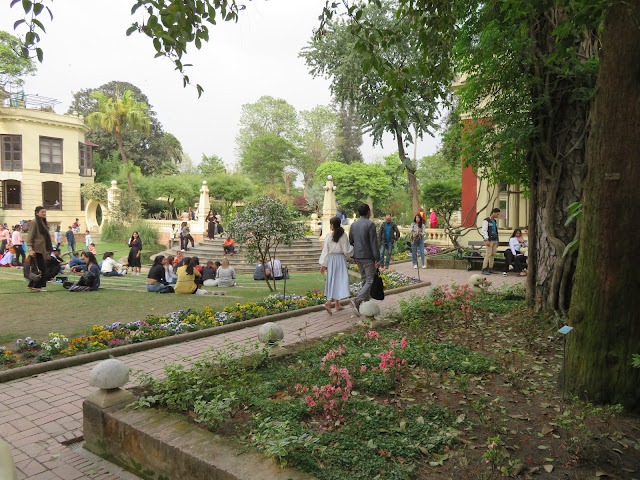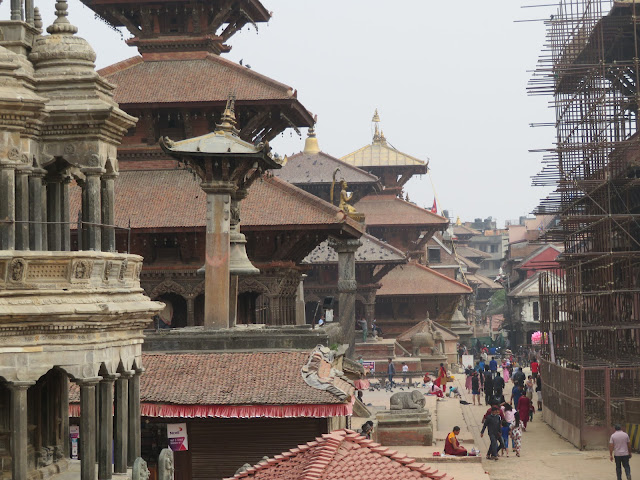For April 2, 2022
So now we’re on to the first full day in Kathmandu. Renee and I had booked a tour to visit Patan and Bhaktapur. Our tour guide was a guy named Kidar, who had previously been the president of the Nepal Tourism department. He worked to make sure guides were knowledgeable about what they were giving tours of and visit shops to look for places people might be interested in visiting. This basically meant he knew everyone and everything. The best sort of guide to have.
The main places we visited on this day were both Durbar Squares, which basically means Royal Square. Patan and Bhaktapur were two of the three kingdoms within the Kathmandu Valley (the other being Kathmandu itself). The squares are filled with temples and royal buildings and palaces. And all three Durbar Squares in the Kathmandu Valley received significant damage in the 2015 earthquake. In case you don’t remember, that earthquake occurred in April 2015. It was registered as an 8.1 on the Richter scale, and killed nearly 9,000 people in Nepal. The earthquake also triggered an avalanche on Everest that killed 22. Some large aftershocks also occurred in the following month.
Patan Durbar Square
The temples are on the left, while the palace is hidden just out of view to the right.
We started out the day in Patan walking through the lane between the temples and the royal buildings. The temples were to our left and the royal buildings on the right. Kidar told us what each building was and if it was a temple, who it was a temple for. I learned that in Nepal pigeons are considered good luck and he asked us if people thought well of pigeons in the United States (uh, no, not really). We didn’t go in any of the temples (most are only open to Hindus). A number of the temples and parts of the royal buildings had to be rebuilt after the earthquake, and while most were completed, there were still a few in the process of being fixed.
Because it was too early to go into the Royal Palace at Patan, we walked a few streets over to a Buddhist temple known as the Golden Temple, because, well, there’s a lot of gold in it. While here we got a brief rundown on Hinduism and Buddhism. They’re related, but different religions in a similar way to how Judaism, Christianity, and Islam are related. They have some overlapping gods, beliefs, and practices, but also have some things that are uniquely theirs. In short, Buddha was born and raised a Hindu, but set out to find nirvana (liberation from suffering) and after finding it, followers wanted to follow the same path to find enlightenment.
 |
| Golden Temple |
After finishing up at the Golden Temple, but before we returned to Patan Durbar Square to tour the Royal Palace buildings, we stopped at this shop that sold meditation bowls. That led to Renee and I both getting the chance to experience what it’s like to have a bowl placed upside-down on your head and then banged to help clear your mind (it didn’t). It could, apparently, also be used to help back and leg pain. Just bang it a little while it’s touching you and the vibrations will help your pain. And the handmaid ones are much better and produce a purer sound that lasts longer than the machine made ones.
When this interesting experience was over we headed to the palace at Durbar Square. The palace was filled with elaborate wood carvings, which I found remarkable. Many of them actually had to be redone partially or entirely following the earthquake. There was a segment of the building that was a museum. One of the things it talked about was how when you see pictures or statues of Buddhist or Hindu gods, their hand positions share what sort of mood the picture/statue is trying to get across.
When we finished up at Patan, we got in a car and traveled over to Bhaktapur Durbar Square. This one was laid out much differently. It was a lot more open and you could sort of imagine there being either festivals (Nepal loves festivals) or a market in the square. This square wasn’t as far along in its revitalization post earthquake. The palace was still closed due to damage and a few of the temples were still being reworked, but it was a neat place to visit. This was also where we had an interesting conversation about kama sutra, which was started after pointing out figures carved in a temple beam. Kidar told us all about how the younger generations are more free about sex and it has led to more STDs. And how kids are now brought down to the temple to learn about sex education.
In Bhaktapur there is a large 5 story temple, that in English they call the 5 Story Temple. It had a 5 story pagoda roof and 5 levels, with each one having 2 guardians on its steps. It looked down into a square with a large temple across the way and a large cart that we were told is pulled around on Nepali New Year, which was only days away.
 |
| The 5 Story Temple of Bhaktapur |
A few streets beyond the 5 Story Temple was the pottery district. Here artisans were making pots, dying, and firing them. The people we saw making pots, could make one in the matter of a minute or two. They were so fast. And the kilns…goodness…they were stuffed full. I have no idea how they get the pots out without breaking them, they’re so tightly stuff in there.
 |
| One of the kilns full of pottery after they've been fired. |
As we made our way back from the pottery district towards the Durbar Square, we passed a place that made kukri, a Gurkha knife. The Gurkhas are a well known, well trained group of Nepali soldiers who are part of the Nepali, Indian, and British Army, as well as having a small contingent involved in UN peacekeeping missions. We also stopped by an art school where students are taught how to make mandalas. We learned about the 3 most common types of traditional mandalas, which usually allude to the spiritual journey of life, at least the ones found in Nepal do.
After returning to the hotel, following the conclusion of our tour, Renee and I walked around a bit. We first went to the Garden of Dreams, which was built in the early 1900s before being abandoned for a while. It was then brought back to life in the early 2000s. It was a Saturday so there were a ton of people at the Garden. Tons of teens doing TikTok dances and taking Instagram photos…basically the same thing you see American teens doing. The Garden was pretty and a neat green oasis in a city that didn’t have a lot of green.
 |
| Garden of Dreams in the middle of Kathmandu |
From the Garden of Dreams we made our way to the Asan Bazaar, which was crowded, chaotic, and had all the counterfeit items you could want. Shoes and clothes, mainly. There were also shops that sold all varieties of goods. Overall it was a very busy day.



No comments:
Post a Comment